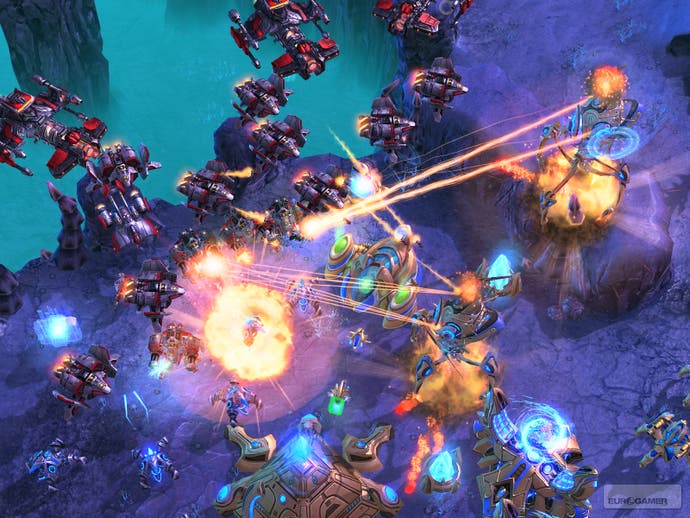StarCraft II
The new adventures of old faithful.
StarCraft II is fast. Really, really fast. But lead designer Dustin Browder talks faster. The bald-headed, sharp-eyed veteran of Command & Conquer titles, hired in by Blizzard to take command of this sequel to its decade-old real-time strategy warhorse, jumps into questions halfway through and peppers you with rattling bursts of ideas and arguments. It's like he's involved in a constant game of StarCraft II in his head, where precision, pre-emption, and speed of execution are absolutely everything.
Blizzard gathered press at its California HQ this week to reveal the Zerg, the last of the classic trinity of races from the 1998 original. With all three races in place, there was also the first chance to try out the essential core of the game: blisteringly quick multiplayer matches between the dogged Terrans, hi-tech Protoss and the mutating bio-weapons of the Zerg. Although more than half the units in the game are new, that core - from interface to perspective to mechanics to, most importantly, speed - remains virtually unchanged from the one that birthed one of the longest-lasting multiplayer communities, and most active eSports scenes, that gaming has ever seen. Whether building bases and armies, or micro-managing units in battle, in StarCraft II the fastest mouse always wins.
Weren't they ever tempted to slow it down a bit? "No! Not StarCraft," says Browder. "There's something to be said for that kind of fun. You know it's just, 'Gogogo! Oh I lost. Gogogogogo! Oh I won! Gogogogo.' And then you just play again and again. I think that was a kind of fun that we wanted to create again, that the team wanted to do, and it's certainly the kind of RTS that I prefer."
Lead producer Chris Sigaty - the laid-back, long-haired yin to Browder's yang - reinforces the point: Blizzard at no point considered reinventing this particular wheel. "One of the things we hear is, what's the new big thing you're bringing to reinvent RTS? And I'm like, well, we're not," he states flatly.

"We made a conscious decision not to... One of the things that played into our decision was just how popular the original game still is. Had it been different, had it spiked up and sold well and then disappeared... maybe putting first-person elements might have been something that we'd considered. But we never considered that. Stay true to the original; stick with the original three races; make them more diverse."
True to the original it certainly is. Familiarity is instant to anyone who's played StarCraft, and to some extent Warcraft III: the screen layout, the tight camera that apes the original's isometric display, the slight sense of claustrophobia and panic, the simple but effective unit designs, the tendency away from methodical empire-building and towards sudden, heart-in-mouth raids, and of course the seemingly limitless capacity for micro-management that allows the 300-actions-per-minute Korean pro-gamers to manipulate vast armies on several fronts on an almost unit-by-unit basis.
It's both intoxicating and intimidating. There's certainly an adrenalised rush to it - and the astonishingly vivid, distinctive and beautifully animated new visuals are a powerful draw. But playing against seasoned StarCraft campaigners leaves you with no time to even begin to explore the expanded possibilities of StarCraft II's more involved research and tech trees. Perhaps it's just that no-one is fully familiar with the new set-up, but deep-seated patterns seem to reassert themselves very quickly. It's a pitfall Browder is aware of, and he's working to avoid it, in part through more sophisticated map design: line of sight barriers, placing high-yield minerals behind walls of rocks that take protracted and concentrated fire to take down, and so on.

